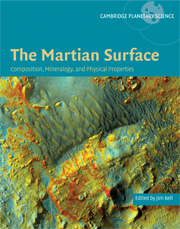Book contents
- Frontmatter
- Contents
- List of contributors
- Foreword
- Acknowledgments
- Part I Introduction and historical perspective
- Part II Elemental Composition: Orbital and in situ Surface Measurements
- Part III Mineralogy and Remote Sensing of Rocks, Soil, Dust, and Ices
- 7 Mineralogy of the Martian surface from Mars Express OMEGA observations
- 8 Visible to near-IR multispectral orbital observations of Mars
- 9 Global mineralogy mapped from the Mars Global Surveyor Thermal Emission Spectrometer
- 10 The compositional diversity and physical properties mapped from the Mars Odyssey Thermal Emission Imaging System
- 11 Mars' crustal magnetization: a window into the past
- 12 Multispectral imaging from Mars Pathfinder
- 13 Mars Exploration Rover Pancam multispectral imaging of rocks, soils, and dust at Gusev crater and Meridiani Planum
- 14 The mineralogy of Gusev crater and Meridiani Planum derived from the Miniature Thermal Emission Spectrometers on the Spirit and Opportunity rovers
- 15 Iron mineralogy and aqueous alteration on Mars from the MER Mössbauer spectrometers
- 16 Magnetic properties of Martian surface materials
- 17 Martian meteorites as crustal samples
- Part IV Physical Properties of Surface Materials
- Part V Synthesis
- Part VI Summary, Upcoming Missions, and New Measurement Needs
- Index
- Plate section
- References
9 - Global mineralogy mapped from the Mars Global Surveyor Thermal Emission Spectrometer
from Part III - Mineralogy and Remote Sensing of Rocks, Soil, Dust, and Ices
Published online by Cambridge University Press: 10 December 2009
- Frontmatter
- Contents
- List of contributors
- Foreword
- Acknowledgments
- Part I Introduction and historical perspective
- Part II Elemental Composition: Orbital and in situ Surface Measurements
- Part III Mineralogy and Remote Sensing of Rocks, Soil, Dust, and Ices
- 7 Mineralogy of the Martian surface from Mars Express OMEGA observations
- 8 Visible to near-IR multispectral orbital observations of Mars
- 9 Global mineralogy mapped from the Mars Global Surveyor Thermal Emission Spectrometer
- 10 The compositional diversity and physical properties mapped from the Mars Odyssey Thermal Emission Imaging System
- 11 Mars' crustal magnetization: a window into the past
- 12 Multispectral imaging from Mars Pathfinder
- 13 Mars Exploration Rover Pancam multispectral imaging of rocks, soils, and dust at Gusev crater and Meridiani Planum
- 14 The mineralogy of Gusev crater and Meridiani Planum derived from the Miniature Thermal Emission Spectrometers on the Spirit and Opportunity rovers
- 15 Iron mineralogy and aqueous alteration on Mars from the MER Mössbauer spectrometers
- 16 Magnetic properties of Martian surface materials
- 17 Martian meteorites as crustal samples
- Part IV Physical Properties of Surface Materials
- Part V Synthesis
- Part VI Summary, Upcoming Missions, and New Measurement Needs
- Index
- Plate section
- References
Summary
ABSTRACT
The Thermal Emission Spectrometer (TES) on Mars Global Surveyor (MGS) mapped the surface, atmosphere, and polar caps of Mars from 1997 through 2006. TES provided the first global mineral maps of Mars, and showed that the surface is dominated by primary volcanic minerals (plagioclase feldspar, pyroxene, and olivine) along with high-silica, poorly crystalline materials. Differences in the abundances of these minerals were initially grouped into two broad compositional categories that correspond to basalt and basaltic andesite. Additional analysis has identified four surface compositional groups that are spatially coherent, revealing variations in the composition of the primary crust-forming magmas through time. In general, plagioclase, high-Ca clinopyroxene, and high-silica phases are the dominant mineral groups for most regions, with lesser amounts of orthopyroxene, olivine, and pigeonite. One of the fundamental results from the TES investigation was the identification of several large deposits of crystalline hematite, including those in Meridiani Planum, that were interpreted to indicate the presence of liquid water for extended periods of time. This interpretation led to the selection of Meridiani as the target for the Opportunity rover, the first time that a planetary landing site was selected on the basis of mineralogic information. Aqueous weathering may have formed some of the high-silica phases seen in TES spectra at high latitudes, and the Mars Express Observatoire pour la Minéralogie, l'Eau, les Glaces et l'Activité (OMEGA) spectrometer has detected phyllosilicates and sulfates, typically formed by aqueous weathering and deposition, in several locations.
- Type
- Chapter
- Information
- The Martian SurfaceComposition, Mineralogy and Physical Properties, pp. 193 - 220Publisher: Cambridge University PressPrint publication year: 2008
References
- 6
- Cited by

